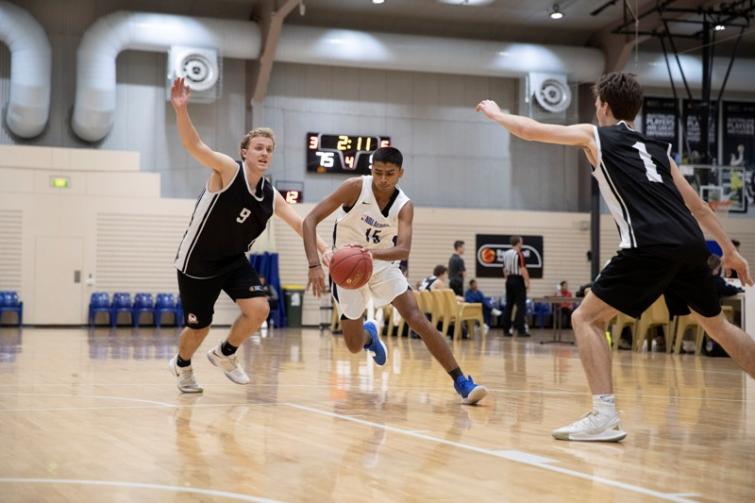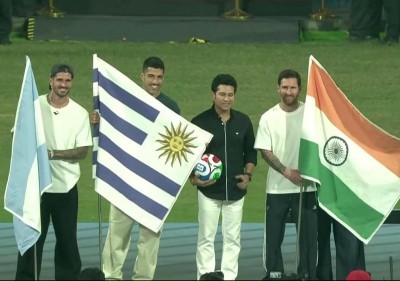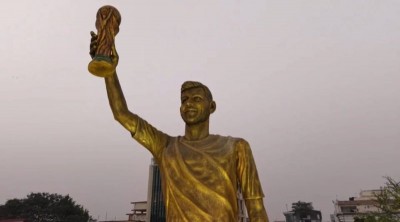
In India, basketball begins to take root
Like millions of American kids, 11-year-old Arsh Singh of Uttar Pradesh, India, fell in love with basketball from his first dribble.
“My elder brother is a fan,” he said. “I used to play the game at home, and after playing it I just loved the game and I decided to get into an academy.”
Basketball is gradually taking root among young people in India, a country known more for cricket runs than free throws. And the NBA in the United States is taking advantage of this budding interest to grow the game internationally.
Arsh hones his basketball skills at Ramagya Sports Academy in Noida, a city on the outskirts of New Delhi. Ramagya is one of three Indian schools housing the NBA’s Basketball School initiative, which encourages kids ages of 6 to 18 to learn the game.
In May 2017, the NBA launched The NBA Academy India, an elite basketball training center at Jaypee Greens Integrated Sports Complex in Delhi National Capital Region (NCR). The first NBA Basketball School was launched in Mumbai as part of a multiyear agreement with India On Track (IOT), one of India’s leading sports management, marketing and development companies.
.jpg)
Image: Young basketball aspirants at Ramagya Sports Academy in Noida one of three Indian schools housing the NBA’s Basketball School initiative.
The NBA earlier launched NBA Basketball School, a network of tuition-based basketball development programs around the world open to international male and female players ages 6-18.
“NBA in India has been set up for many purposes. One is obviously to promote the game and the American league, which is very popular across the world..,” said Abhimanyu Bhalla, operational manager of the NBA Basketball School at Ramagya.
.jpg)
Another is to train potential future players for U.S. teams.
Forbes estimates the average NBA franchise is worth $1.9 billion, and experts say NBA’s growing global influence promises to increase the value of franchises even more.
The NBA has successfully planted seeds in several countries. China’s love for basketball has been well-documented, thanks to NBA teams taking Chinese preseason tours and Miami Heat star Dwyane Wade signing a shoe deal with Chinese conglomerate Li-Ning. European-born players like Kristaps Porzingis and the recently-retired Dirk Nowitzki have thrived.
India, the world’s second most populated country with more than 1.3 billion people, is the newest basketball frontier.
First generation American Rit Kar, a recent University of Missouri graduate and rabid basketball fan, says he considers basketball a global sport that’s only becoming more so.
“I think India is a huge untapped market,” he said, “and it’s only a matter of time before we see more Indian players.”
Basketball Roots Taking Shape
Top Indian-born NBA players have made history in the past few years, sparking interest among children in their home country.
Sim Bhullar became the first Indian basketball player to play in the NBA when he debuted for the Sacramento Kings in 2015. The following offseason, Satnam Singh became the first Indian-born player to be drafted by an NBA team when the Mavericks took him in the second round.
.jpg)
Image: First generation American Rit Kar, a recent University of Missouri graduate and rabid basketball fan, says he considers basketball a global sport that’s only becoming more so.
Kids in Ramagya academy look to players like these for inspiration.
Besides centers like Ramagya, which accepts any children interested in learning the sport, the NBA also runs a center in New Delhi for India’s best young players, which its website says “builds on the NBA’s existing basketball and youth development initiatives in India.”
That center’s 23-player roster, filled entirely by players between 14 and 18 years old, regularly plays Indian college teams. And it’s won more games than it’s lost.
Amid such success, the Indian pipeline to the NBA is bearing fruit. Satnam Singh, whose success precedes the academy, is a role model to these kids.
“NBA schools are currently in 7-8 states in our country,” Bhalla said. “Our vision is to give them a platform in order to get the raw talent out of the Indian youth. Players like Satnam Singh (are) already establishing them in the international field and we are hoping to get more talent like him in the coming future.”
As the sport takes hold in India, the culture surrounding it is spreading, too -- promising millions in profits for American companies. The Nike subsidiary Jordan, for example, routinely charges hundreds of dollars for a pair of sneakers, raking in just under $3 billion per year.
And India provides a huge new customer base.
Basketball’s global future
Missouri grad Kar was born in India and moved to Hershey, Penn., as a child, becoming a diehard supporter of the Philadelphia 76ers. After orchestrating one of the most dramatic multi-year turnarounds in league history, Kar’s 76ers are at the forefront of the modern NBA.
On a recent day, he sat on his couch watching Game 3 of the first-round NBA playoff matchup between the 76ers and Brooklyn Nets. He was amped up watching franchise cornerstones Joel Embiid, Ben Simmons, and Jimmy Butler.
“[Joel] Embiid is a unicorn,” he said as he watched the game. “He does everything for us. After how bad we were, it’s nice to have a roster like this.”
The emotions of a sports fan vary wildly between games and season, but Kar’s fellow Philadelphia fans can be ruthless.
.jpg)
“Philly fans are Philly fans,” Kar said. “When they [the 76ers] actually won a few games, you know, there were serious cheers, but they’d still boo the other team...”
Kar admits that cricket is still king in India, and said there’s good reason to believe it always will be.
But Kar wouldn’t be surprised to turn on the TV one day and see more players from his home country on the court -- along with players from nearly every part of the world. He said the 76ers started the season with a “UN lineup” including a guy from Australia, another from Cameroon and a third from Croatia.
“You have all these different players from different parts of the world, in different stages of their careers,” he said. “They play the game in different ways, but they come together as a team for the greater good.”
(This story is part of a series of special reports on India and the U.S. undertaken by the University of Missouri Journalism students. It was overseen by Laura Ungar, Midwest Editor/Correspondent with the St. Louis bureau of Kaiser Health News, and journalist Sujoy Dhar, founder of the Indian news agency India Blooms News Service.)
Support Our Journalism
We cannot do without you.. your contribution supports unbiased journalism
IBNS is not driven by any ism- not wokeism, not racism, not skewed secularism, not hyper right-wing or left liberal ideals, nor by any hardline religious beliefs or hyper nationalism. We want to serve you good old objective news, as they are. We do not judge or preach. We let people decide for themselves. We only try to present factual and well-sourced news.






